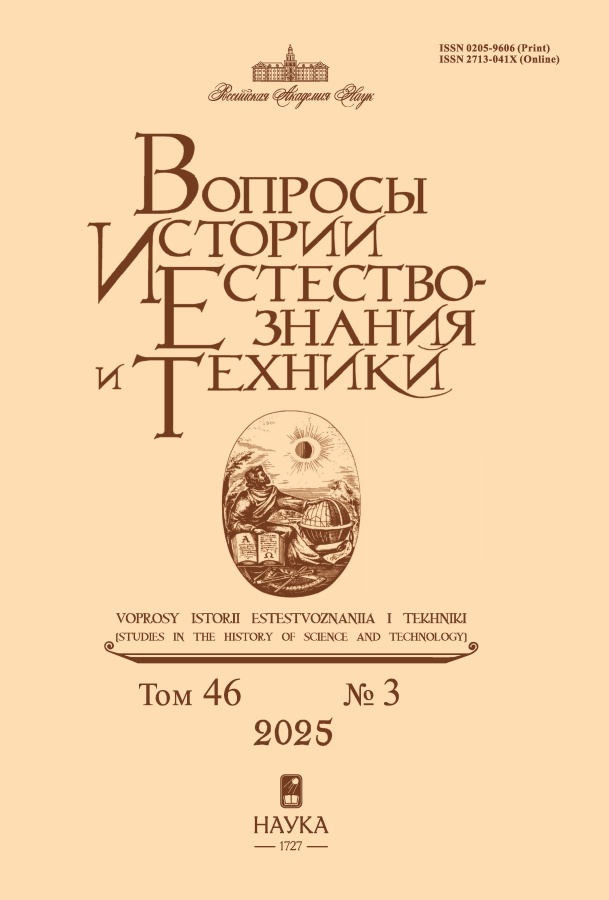Voprosy istorii estestvoznaniia i tekhniki
The peer-review journal Voprosy istorii estestvoznaniia i tekhniki (VIET) ["Studies in the History of Science and Technology"] journal was founded in 1980 on the basis of an irregularly published collection of works by employees of the Institute for the History of Science and Technology of the Academy of Sciences of the USSR (IHST of the USSR Academy of Sciences).
Founders
- Russian Academy of Sciences
- Institute for the History of Science and Technology
Publisher
- Russian Academy of Sciences
About the journal
The main block of the journal's materials is formed by original articles presenting research results of qualified specialists in the history and philosophy of science and technology. The scientific level of the results and the compliance of articles with publication standards is ensured by a representative editorial board, which includes two academicians (RAS), one corresponding member of the RAS, doctors and candidates of sciences.
The contents of the journal are divided into main sections reflecting the scope and specifics of the proposed scientific publications:
- General Problems of the History of Science and Technology
- From the History of Science
- Social History of Science
- From the History of Technology
- Lessons from History
- Materials for the Biographies of Scientists and Engineers
- Institutions and Museums
- Sources for the History of Science and Technology
The information block contains memoirs, reviews, books reviews, annotations for defended dissertations, as well as information about past conferences and correspondence with readers.
The journal is published quarterly and is included in the "List of peer-reviewed scientific publications" of the Higher Attestation Commission of Russian Federation and the Russian Science Citation Index in Web of Science.
Media registration certificate: № 0110149 от 04.02.1993
Edição corrente
Volume 46, Nº 3 (2025)
- Ano: 2025
- Artigos: 13
- URL: https://consilium.orscience.ru/0205-9606/issue/view/14008
Edição completa
From the History of Science
Mineral Resource Exploration in the European North-East of the USSR, Led by A. A. Chernov (1930s – 1940s)
Resumo
 433-444
433-444


Social History of Science
Activities of the Novaya Zemlya subcommission under the Russian Academy of Sciences: On the scientific exploration of Novaya Zemlya in the 1920s
Resumo
 445-461
445-461


From the History of Technology
The History of the Construction of the Ligovsky Canal, Its Storage Reservoirs and Water Towers (First Half of the 18th Century)
Resumo
 462-488
462-488


The History of Creation and Development of Space Telemetry Facilities in the USSR (Second Half of the 1940s – 1970s)
Resumo
 489-510
489-510


Lessons from History
How IBM Won: Changes in Government Policy Concerning the Development of Computing Technology in the USSR in the Second Half of the 1960s.
Resumo
 511-523
511-523


Historical Reviews
The History of Formation of Biosphere Approach in Evolutionism in the USSR
Resumo
 524-539
524-539


The History of Morphological Research in Kursk (1935–1991)
Resumo
 540-559
540-559


Essay Review
Exhibition as an Instrument for Popular Presentation of Scientific and Technical Knowledge (On the Example of O. Yu. Elinaʼs Book “Pictures from the Exhibition: Science and Technology in the Early USSR (Based on the Materials of the All-Russian Exhibition of 1923)”)
 560-566
560-566


Books in Brief
Books in Brief
 567-570
567-570


Academic Life
Section “Studies of K. E. Tsiolkovskyʼs Scientific Work and the History of Rocket and Space Science and Technology” at the 59th Scientific Readings Devoted to the Development of K. E. Tsiolkovskyʼs Scientific Heritage and Ideas
 571-577
571-577


Scientific Conference “The Works and Days of Boris Jakobi: In Commemoration of the 150th Anniversary of His Death”
 578-582
578-582


Exhibitions Devoted to the 300th Anniversary of the Russian Academy of Sciences at the Library for Natural Sciences of the Russian Academy of Sciences
 583-589
583-589


Events in Brief
Events in Brief
 590-592
590-592















